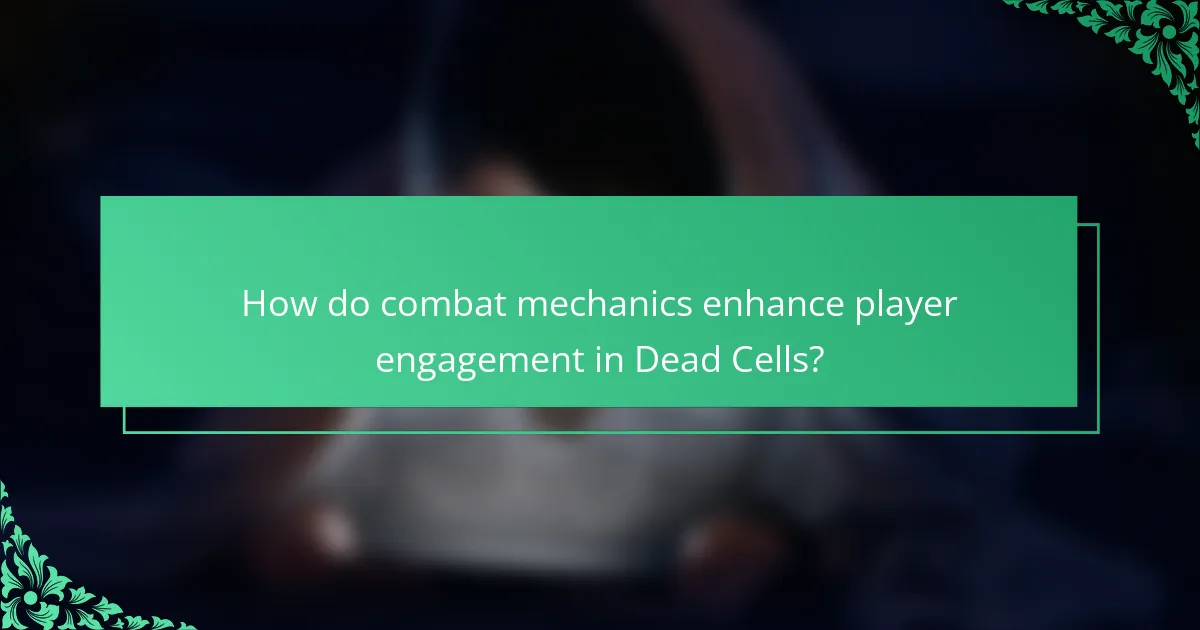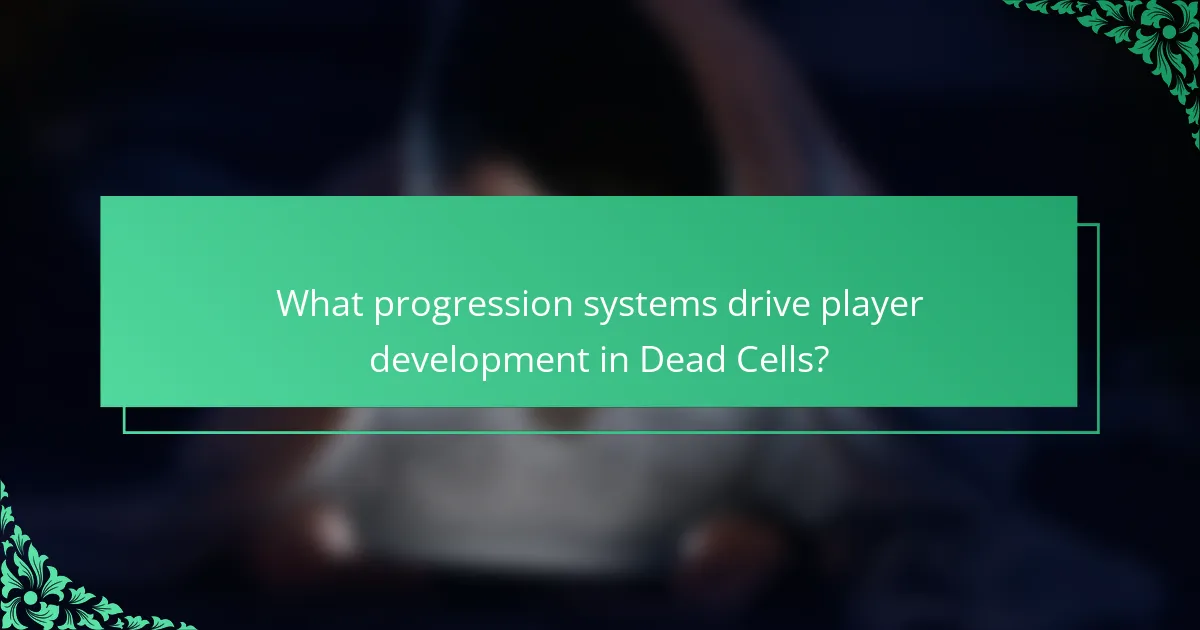Dead Cells offers an engaging experience through its dynamic combat mechanics, immersive exploration, and rewarding progression systems. Players can experiment with various weapons and skills, adapting their strategies in real-time. The procedurally generated environments encourage discovery, while the progression system enhances character development and combat effectiveness. Each choice shapes the gameplay, creating a personalized adventure in this rogue-lite platformer.

How do combat mechanics enhance player engagement in Dead Cells?
Combat mechanics in Dead Cells significantly enhance player engagement by providing dynamic, responsive gameplay. These mechanics create a sense of urgency and excitement, encouraging players to adapt their strategies in real-time.
The variety of weapons and skills allows for diverse combat styles, catering to different player preferences. Each weapon has unique attributes, such as speed, damage, and effects, which influence how players approach encounters. This variety keeps gameplay fresh and encourages experimentation.
Additionally, the integration of enemy behaviors and environmental interactions adds layers of complexity. Players must learn enemy patterns and utilize the environment to their advantage, fostering a deeper connection to the game world.
The progression system further enhances engagement by rewarding skill development and exploration. Players unlock new abilities and upgrades, making combat feel rewarding and encouraging continued play. This combination of mechanics creates a compelling loop that keeps players invested in their journey through Dead Cells.
What types of weapons and abilities are available for combat?
Dead Cells offers a variety of weapons and abilities for combat, including melee weapons, ranged weapons, and skills. Melee options consist of swords, whips, and shields, while ranged choices include bows and crossbows. Skills provide unique effects, such as teleportation or area damage. Each weapon has distinct attributes, enhancing combat strategies and player preferences.
How does the timing of attacks influence combat effectiveness?
The timing of attacks significantly impacts combat effectiveness in Dead Cells. Strategic timing allows players to exploit enemy vulnerabilities and maximize damage output. For instance, attacking after a dodge increases critical hit chances. Additionally, understanding enemy patterns facilitates more effective counterattacks, enhancing overall gameplay efficiency. Timing also influences the use of skills and items, allowing for optimal resource management during combat encounters. Players who master attack timing experience smoother progression and improved survival rates.
Why are combos and skill chains important in gameplay?
Combos and skill chains are essential in gameplay as they enhance damage output and create fluid combat experiences. These mechanics enable players to string together attacks, maximizing efficiency and effectiveness in defeating enemies. Mastering combos leads to higher scores and rewards, while skill chains allow for strategic play, adapting to different enemy types. The synergy between these elements fosters a dynamic and engaging gameplay environment, encouraging exploration of various combat styles.
Which enemy types challenge combat strategies?
Various enemy types in Dead Cells present unique challenges to combat strategies. These include melee attackers, ranged foes, and elite enemies, each requiring different tactics.
Melee attackers often rely on aggressive close-range strikes, necessitating careful dodging and timing. Ranged enemies can deal damage from a distance, prompting players to utilize cover and mobility. Elite enemies combine multiple attack patterns, demanding adaptability and quick decision-making.
Understanding these enemy types enhances combat effectiveness, allowing players to tailor their strategies and improve survival chances.

What exploration elements contribute to the game’s immersive experience?
Exploration elements in Dead Cells enhance immersion through diverse environments, dynamic level design, and interlinked pathways. The procedurally generated maps create unique experiences, encouraging players to adapt their strategies. Environmental storytelling enriches the narrative, while hidden areas reward exploration. These elements foster a sense of discovery and engagement, crucial for the gameplay experience.
How do procedurally generated levels affect exploration?
Procedurally generated levels enhance exploration by creating unique environments each playthrough. This unpredictability encourages players to adapt their strategies and discover new pathways. The varied layouts foster a sense of adventure, making exploration rewarding. Additionally, the randomness can lead to unexpected encounters and challenges, enriching the gameplay experience.
What role do hidden areas and secrets play in player discovery?
Hidden areas and secrets enhance player discovery by rewarding exploration and encouraging curiosity. In “Dead Cells,” these elements provide unique items, shortcuts, and lore, deepening engagement. Players uncover hidden paths that lead to valuable resources, creating a sense of achievement. This design choice fosters a dynamic gameplay experience, making exploration essential for progression.
How does verticality in level design impact navigation?
Verticality in level design enhances navigation by creating distinct pathways and encouraging exploration. In “Dead Cells,” verticality allows players to discover hidden areas, utilize diverse combat strategies, and engage with the environment dynamically. This design choice promotes a sense of progression as players master vertical movement mechanics, such as wall jumps and grappling. Additionally, verticality influences enemy placement and encounters, making navigation more strategic and rewarding.

What progression systems drive player development in Dead Cells?
Dead Cells employs various progression systems that enhance player development through skill acquisition and item upgrades. Players can unlock new weapons, abilities, and mutations, which significantly impact combat strategies and exploration methods. The game features a rogue-lite structure, where each run allows players to collect resources, enabling permanent upgrades and character enhancements. Unique attributes include the diverse weapon types and synergy between abilities, which provide players with multiple approaches to challenges. Additionally, rare attributes like the ability to alter the game’s environment through specific items further enrich the gameplay experience.
How do upgrades and unlocks influence gameplay style?
Upgrades and unlocks significantly shape gameplay style in Dead Cells by enhancing character abilities and encouraging diverse strategies. Players can customize their combat approach through various weapon upgrades and skills, leading to unique playstyles. For instance, unlocking new weapons allows for different attack patterns, while upgrades can boost damage or add elemental effects. This flexibility promotes experimentation, as players can adapt their strategies based on the challenges they face. Ultimately, the interplay of upgrades and unlocks fosters a dynamic gameplay experience, encouraging players to refine their tactics and explore different paths through the game.
Which currency systems are used for character progression?
In Dead Cells, character progression utilizes multiple currency systems including Cells, Gold, and Blueprints. Cells are earned from defeated enemies and are essential for unlocking upgrades. Gold is collected throughout levels and can be spent on items and equipment. Blueprints allow players to craft weapons and gear, enhancing their combat abilities.
What is the significance of permanent upgrades versus temporary boosts?
Permanent upgrades in Dead Cells provide lasting enhancements to your character, while temporary boosts offer short-term advantages. Permanent upgrades enhance core abilities, making them essential for long-term progression. These upgrades can significantly increase health, damage output, or mobility, contributing to a more robust gameplay experience. In contrast, temporary boosts can be powerful but are limited in duration, requiring strategic use during specific encounters. Understanding the balance between these two types of enhancements is crucial for mastering combat and exploration.

How do player choices affect the overall experience in Dead Cells?
Player choices significantly shape the overall experience in Dead Cells by influencing combat strategies, exploration routes, and progression outcomes. Each choice impacts the player’s ability to adapt to challenges, select weapons, and utilize abilities effectively. For instance, choosing different weapons alters combat mechanics, leading to varied playstyles. Exploration decisions affect the discovery of secrets and shortcuts, enhancing the game’s depth. Progression systems allow players to customize their character builds, which can lead to unique gameplay experiences. Ultimately, these choices create a dynamic and personalized adventure within the game’s world.
What impact do different difficulty settings have on gameplay?
Different difficulty settings in Dead Cells significantly impact gameplay by altering enemy strength, resource availability, and player resilience. Higher difficulty increases enemy damage and health while reducing healing options. This creates a more challenging environment that requires strategic planning and skillful combat. Conversely, lower difficulty settings make the game more accessible, allowing players to explore and progress without overwhelming challenges. Each setting caters to different player experiences, enhancing engagement and replayability.
Which strategies can players use to optimize their builds?
Players can optimize their builds in Dead Cells by focusing on synergy between weapons, upgrades, and mutations. Prioritize weapons that complement each other, such as combining ranged and melee options. Invest in mutations that enhance damage output or survivability, like “Rage” for increased attack power or “Vampirism” for health recovery. Experiment with different combinations to discover effective playstyles tailored to individual preferences. Additionally, adapt builds based on the enemies faced and environmental challenges encountered in each biome.

What are common mistakes players make when mastering combat mechanics?
Players often make mistakes in Dead Cells by neglecting timing, overcommitting to attacks, and ignoring dodge mechanics. Common errors include failing to adapt to enemy patterns, which can lead to avoidable damage. Another frequent mistake is underutilizing environmental elements, such as traps and ledges, which can enhance combat effectiveness. Lastly, players may overlook the importance of upgrading weapons and abilities, missing opportunities to improve their combat performance.
How can players effectively learn from their failures in-game?
Players can learn from their failures in Dead Cells by analyzing their mistakes and adjusting strategies accordingly. Reflecting on combat encounters helps identify weaknesses in timing and positioning. Exploring different weapons and abilities allows players to understand their strengths and weaknesses. Additionally, utilizing the game’s progression systems effectively can enhance resilience in subsequent attempts. Engaging with community discussions can provide insights and alternative strategies to improve gameplay.
What best practices should players adopt for efficient exploration?
Players should adopt strategic navigation, thorough exploration, and effective use of abilities for efficient exploration. Prioritize unlocking shortcuts to facilitate backtracking. Utilize the map to identify unexplored areas, ensuring no secrets are missed. Experiment with different weapons and abilities to enhance movement and combat efficiency. Engaging with enemies can also yield valuable resources, aiding progression.
Which tips can enhance the understanding of progression systems?
To enhance the understanding of progression systems in Dead Cells, focus on key strategies. First, prioritize upgrading weapons and gear to improve combat efficiency. Second, explore different biomes thoroughly to unlock new abilities and resources. Third, familiarize yourself with the synergies between items and skills to maximize effectiveness. Lastly, practice adaptability by experimenting with various builds to find the most effective strategies for different challenges.


